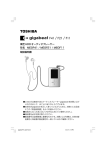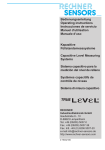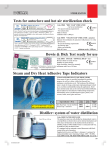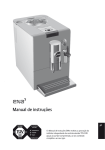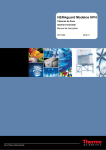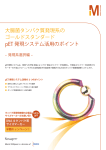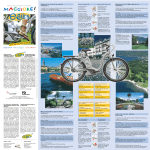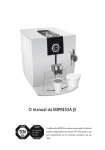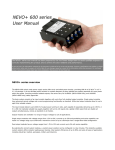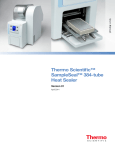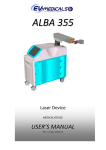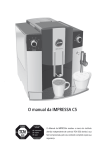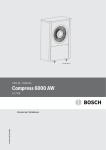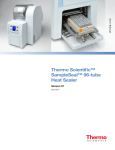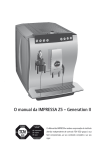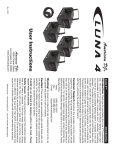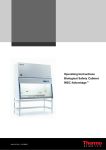Download - Frank`s Hospital Workshop
Transcript
GB Safety Cabinets Class 2 Operating instructions Valid: 09.2005 / 50047299 C These operating instructions apply to the following unit equipment levels: Model Equipment HS Units with intake protection pre-filters HSP Units with HOSCH pre-filters HSPC Units with activated charcoal pre-filters HS. . . ./85 Units with increased interior height Neither these instructions nor any part thereof may not be reproduced or distributed without the express written approval of Thermo Electron LED GmbH. This version applies to operating instructions for series production safety workbenches. These operating instructions may be expanded to include accessories. Various sections of this manual may only be copied for the internal use of the operator, e.g., for personnel safety and accident prevention training. These sections are indicated in the contents. Thermo Electron LED GmbH assumes no liability or responsibility for the suitability of the units for a particular purpose aside from those listed in the section dealing with the unit's areas of application. We reserve the right to make changes to the content of these operating instructions at any time and without prior notification. For all translations into foreign languages, the original German version of these operating instructions is binding. Published: 09.2005 Subject to fee. Trademarks HERAsafe ® and the term "Heraeus" are registered trademarks of Thermo Electron LED GmbH. Any other trademarks mentioned are the exclusive property of the manufacturers in question. © Thermo Electron LED GmbH, 63505 Langenselbold, Germany 2/27 50 047 299 Below is a list of the international Thermo marketing organizations. Postal address Germany Thermo Electron LED GmbH D – 63505 Langenselbold Robert-Bosch-Strasse 1 Enquiries from Germany Phone Sales 0800 1 536376 Service 0800 1 112110 Fax Sales/Service 0800 1 112114 E-Mail [email protected] Enquiries from Europe, Middle East and Africa Phone + 49(0) 6184 / 90-6940 Fax + 49(0) 6184 / 90-7474 E-Mail [email protected] Postal address USA Thermo Electron Corporation. 275 Aiken Road Asheville, NC 28804 USA Enquiries from North America Phone + 1 800-879 7767 Fax + 1 828-658 0363 E-Mail [email protected] Enquiries from Latin America Phone + 1 828-658 2711 Fax + 1 828-645 9466 E-Mail [email protected] Enquiries from Asia Pacific Phone + 1 852-2711 3910 Fax + 1 852-2711 3858 E-Mail [email protected] Internet: www.thermo.com 2a WEEE Compliance: This product is required to comply with the European Union`s Waste Electrical & Electronic Equipment (WEEE) Directive 2002/96/EC. It is marked with the following symbol: Thermo Electron has contracted with one or more recycling/disposal companies in each EU Member State, and this product should be disposed of or recycled through them. Further information on Thermo Electron`s compliance with these Directives, the recyclers in your country, and information on Thermo Electron products wich may assist the detection of substances subject to the RoHS Directive are available at www.thermo.com/WEEERoHS. 2b CONTENTS Page Connection to Laboratory Exhaust Systems . . 18 GLOSSARY . . . . . . . . . . . . . . . . . . . . . . . . . . . . . . . . 2 CONTENTS . . . . . . . . . . . . . . . . . . . . . . . . . . . . . . . . 3 6. OPERATION . . . . . . . . . . . . . . . . . . . . . . . . . . . . . . 19 Safety check, initial startup . . . . . . . . . . . . . . . . . . 19 - Prior to Startup . . . . . . . . . . . . . . . . . . . . . . . . . . . . 19 Starting up the safety cabinet . . . . . . . . . . . . . . . . 19 - Work / operating interruptions . . . . . . . . . . . . . . 19 - UV disinfection mode . . . . . . . . . . . . . . . . . . . . . . 20 Working Guidelines . . . . . . . . . . . . . . . . . . . . . . . . . 20 Problems . . . . . . . . . . . . . . . . . . . . . . . . . . . . . . . . . . . 21 Taking the unit out of service . . . . . . . . . . . . . . . . 21 CONTENTS 1. OVERVIEW . . . . . . . . . . . . . . . . . . . . . . . . . . . . . . . . . Control Panel . . . . . . . . . . . . . . . . . . . . . . . . . . . . . . . . Explanation of Control Panel Elements . . . . . . . . Key to Symbols . . . . . . . . . . . . . . . . . . . . . . . . . . . . . . 4 4 5 5 2. NOTES CONCERNING ENVIRONNEMENTAL SAFETY . . . . . . . . . . . . . . . . . . . . . . . . . . . . . . . . . . . . Disposal of Shipping Packing Material . . . . . . . . . Disposal of Used Equipment . . . . . . . . . . . . . . . . . . Disposal of Used Filter Elements . . . . . . . . . . . . . . Energy Consumption . . . . . . . . . . . . . . . . . . . . . . . . . - Cirrculating air mode . . . . . . . . . . . . . . . . . . . . . . . - Exhaust mode . . . . . . . . . . . . . . . . . . . . . . . . . . . . . . 6 6 6 6 7 7 7 3. SAFETY NOTES . . . . . . . . . . . . . . . . . . . . . . . . . . . . Stickers . . . . . . . . . . . . . . . . . . . . . . . . . . . . . . . . . . . . . . Abbreviated operating instructions . . . . . . . . . . . . Safety Notes . . . . . . . . . . . . . . . . . . . . . . . . . . . . . . . . . 8 8 8 8 (SUMMARY EXCLUDED FROM COPYING PROHIBITION WHEN USED FOR SAFETY INSTRUCTION) Operating Instructions . . . . . . . . . . . . . . . . . . . . . . . 10 Unit Log . . . . . . . . . . . . . . . . . . . . . . . . . . . . . . . . . . . . . 10 Test Chamber Power Sockets . . . . . . . . . . . . . . . . 10 4. DEVICE DESCRIPTION . . . . . . . . . . . . . . . . . . . . 10 Application Area . . . . . . . . . . . . . . . . . . . . . . . . . . . . . 10 Unit Construction . . . . . . . . . . . . . . . . . . . . . . . . . . . . 11 Operating Principle . . . . . . . . . . . . . . . . . . . . . . . . . . 12 Safety Equipment . . . . . . . . . . . . . . . . . . . . . . . . . . . 13 - Power switch with key lock (Function Selection Switch) . . . . . . . . . . . . . . . . 13 - Air monitoring . . . . . . . . . . . . . . . . . . . . . . . . . . . . . 13 - Fuel gas shutoff (option) . . . . . . . . . . . . . . . . . . . 13 - Front window monitoring . . . . . . . . . . . . . . . . . . . 13 - Front window - sealing . . . . . . . . . . . . . . . . . . . . . 13 - UV lock (option) . . . . . . . . . . . . . . . . . . . . . . . . . . . 14 - Lowered working bench (option/accessory) . 14 - Flow interrupter for connection to the laboratory´s ventilation system (accessory) . 14 - Second exhaust filter element (accessory) . . 14 7. MAINTENANCE . . . . . . . . . . . . . . . . . . . . . . . . . . . . 22 Routine Maintenance Tasks . . . . . . . . . . . . . . . . . 22 - Cleaning . . . . . . . . . . . . . . . . . . . . . . . . . . . . . . . . . . 22 Replacing Electrical Parts . . . . . . . . . . . . . . . . . . . 22 Filter Replacement . . . . . . . . . . . . . . . . . . . . . . . . . . 22 - General Information . . . . . . . . . . . . . . . . . . . . . . . 22 - Circulation or exhaust filter replacement . . . . 23 - Intake screen replacement . . . . . . . . . . . . . . . . 23 - Intake Protection Replacement (HS) . . . . . . . 23 - Prefilter replacement (HSP) . . . . . . . . . . . . . . . . 23 Authorized Replacement Parts . . . . . . . . . . . . . . . 24 Authorized Accessories . . . . . . . . . . . . . . . . . . . . . . 24 8. TECHNICAL DATA . . . . . . . . . . . . . . . . . . . . . . . . . 25 Geometry . . . . . . . . . . . . . . . . . . . . . . . . . . . . . . . . . . . 25 Weights, Performance . . . . . . . . . . . . . . . . . . . . . . . 26 Electrical Values . . . . . . . . . . . . . . . . . . . . . . . . . . . . 26 Technical ventilation . . . . . . . . . . . . . . . . . . . . . . . . . 26 Filter Technology . . . . . . . . . . . . . . . . . . . . . . . . . . . . 27 Noise Generation . . . . . . . . . . . . . . . . . . . . . . . . . . . . 27 Illumination Strength . . . . . . . . . . . . . . . . . . . . . . . . 27 Ambient conditions . . . . . . . . . . . . . . . . . . . . . . . . . . 27 5. SETUP AND INSTALLATION . . . . . . . . . . . . . . . 15 Transport . . . . . . . . . . . . . . . . . . . . . . . . . . . . . . . . . . . 15 Setup Location . . . . . . . . . . . . . . . . . . . . . . . . . . . . . . 15 Room Ventilation . . . . . . . . . . . . . . . . . . . . . . . . . . . . 15 Setup . . . . . . . . . . . . . . . . . . . . . . . . . . . . . . . . . . . . . . 16 Spacing . . . . . . . . . . . . . . . . . . . . . . . . . . . . . . . . . . . . . 16 Connections . . . . . . . . . . . . . . . . . . . . . . . . . . . . . . . . . 16 - Power supply . . . . . . . . . . . . . . . . . . . . . . . . . . . . . . 16 - Fittings (accessory) . . . . . . . . . . . . . . . . . . . . . . . . 17 - Fuel gas shutoff connection / nnection to external monitoring systems (Option) . . . . . . . 17 Sound Dampening . . . . . . . . . . . . . . . . . . . . . . . . . . . 18 Version: 02.1999 50 047 299 c 3/27 1. OVERVIEW The safety of this unit with respect to persons, the environment, and the material being processed depends to a great extent on the behavior of those working with the unit. However, even safe operation cannot rule out risk, particularly with respect to the health of personnel. This residual risk depends on the work being performed in each instance. These operating instructions contain important information concerning your safety, the setup and installation of the unit, as well as for its operation and maintenance ! Please read these instructions carefully before operating these units. Follow all instructions in order to avoid problems that may result in damage, in particular, in damage to the user's health. ALWAYS: Wear protective gear in accordance with any applicable regulations and suited to the degree of risk involved with the task at hand (clothing, gloves, protective glasses ...). Implement and follow appropriate hygienic measures. Each person is responsible for his or her own personal safety and health. Control Panel All switches necessary for operation together with all optical and acoustic signaling elements indicating operation and faults are located on the control panel: Figure 1/1: Control panel 12 13 14 15 1 2 h UV UV Made in Germany 11 4/27 10 9 8 7 50 047 299 c 6 5 4 3 Version: 02.1999 1. OVERVIEW Explanation of Control Panel Elements 10 Item No. Symbol 11 Message / Comment Yellow Release active Release key (option, e.g., release error message system, magnetic valve, etc.) Power switch / Function selection switch with key lock: O UV Unit ON: Operation / Normal setting 1 UV Unit ON: Operation with UV surface sterilization irradiator (option) Unit ON: Close front window (in addition to command key) Raise/lower front window key 4 White Window in operating position, Operation 5 Red sockets ON Warnings / Notes / Quality marks Hours of operation counter, e.g., for machine log maintenance. 3 white Key to Symbols Signal Message / Comment h sockets ON / OFF switch 14 Note: The key can be removed and held by the responsible operator, regardless of the switch position, in order to prevent accidental or unauthorized switch use. Item No. Symbol Yellow UV irradiator ON (option) 13 15 Unit ON: Ventilation OFF, power outlets and interior lighting ready It is not possible to work safely with pathogenic material. 2 Started timed UV operation timer key (approx. 60 min) (option) 12 Unit OFF Chapters and sections within the operating instructions that are relevant to safety matters are indicated by this symbol. Biohazard warning ! On the unit, this symbol warns personnel against accidental use. Toxic material warning ! - cytostatic agents On the unit, this symbol warns personnel against accidental use. Note providing information on optimum utilization of the unit. View port not in operating position, OPERATION NOT SAFE Note concerning regulated disposal / reclamation of raw materials. 6 Acoustic warning signal response button 7 Green Ventilation system operating properly, Operation Symbol indicated safety tested in accord. with DIN 12950, Part 10/10.1991 and DIN 12 980. Applies to tested device versions with standard equipment. 8 9 Version: 02.1999 Red Swiss safety certification seal, awarded by the Eidgenössische Starkstrominspektorat Ventilation system fault, OPERATION NOT SAFE GOST R conformity certification for devices exported to the Russian Federation Test chamber light ON / OFF switch 50 047 299 c EU symbol confirming conformity with all relevant European guidelines (nameplate) 5/27 2. NOTES CONCERNING ENVIRONMENTAL SAFETY Disposal of Shipping Packing Material The packaging is designed to protect the unit against shipping damage. Aside from the purely technical aspects of shipping, the packaging materials have been selected with environmental and disposal concerns in mind, and are recyclable. The corrugated cardboard employed is made primarily from recycled paper. Plastic molded parts (Styrofoam) are free of CFCs. Wood frames and pallets are made of recycled wood and are untreated. The polyethylene foil (PE) is made from partially recycled material. The strapping is made of polypropylene (PP). Returning the packaging material to the material circuit saves on raw materials and reduces waste. In general, packaging material can be returned to your dealer. If you will be disposing of the packaging material yourself, please contact your local government for the name of the nearest recycling center. Disposal of Used Equipment Prior to their proper disposal, any equipment employed for microbiological work must be thoroughly disinfected and cleaned. An appropriate confirmation of this is to be included with the equipment being disposed of. Used equipment contains valuable materials. You should not simply take an old unit to the nearest dump or land fill, but should contact your local government department with respect to the required disinfection/cleaning procedures and the possibility of recycling some or all device components and materials. Disposal of Used Filter Elements The service life of the filter elements depends primarily on the type of work being performed, the cleanliness of the environment in the are in which the unit is located, and the device construction. Only you, as the operator can determine the type and degree of possible environmental stress, possibly by also referring to the unit handbook. In cases of microbiological contamination, the filter elements must undergo suitable decontamination measures (sterilization or, at least, disinfection) in order to make them non-hazardous. The proper performance of the selected method is to be confirmed in writing, and this document is to accompany the filter elements being disposed of. The most widely accepted procedure for this is total room disinfection with formaldehyde vapor, followed by neutralization with ammonia vapor. Follow all applicable federal, state, and local ordinances when carrying out this process (in Germany: TRGS 522). As a rule, the filters are passivated after this disinfection procedure. There is practically no risk of contamination with filters employed for safety class 1 and 2 work. For filters employed for safety class 3 work, an additional sterilization step by means of autoclaving the broken up filter material may represent an additional, practical measure. Filters treated in this manner can be viewed as domestic waste and can be disposed of accordingly. The filters can be disassembled for the separate disposal of the filter medium (residual waste) and the aluminum frames. The modalities of the appropriate disposal methods may need to be separately worked out within the context of overall waste management. For the remainder, all applicable federal, state, and local ordinances must be adhered to (in Germany: BImSchG, AbFG ...) Contaminated filter elements are always to be treated in the same manner as any other infectious waste generated by the laboratory. - CAUTION Thermo warns against irresponsible surrender of possibly dangerous filter waste to persons without the necessary hazardous waste transport certificates and permits for the disposal of hazardous waste material. As the originator, you are responsible for this waste material. Noncompliance with the regulated procedures for waste disposal may make you liable for subsequent damages. If the filters must be replaced during operation, the type and extent of possible contamination must be considered. Depending on the type and degree of usage, adequate safety measures for the proper disposal of used filters must be in place prior to replacement. 6/27 50 047 299 2. NOTES CONCERNING ENVIRONMENTAL SAFETY Should you encounter problems in disinfecting - and thus in neutralizing - the filter elements in question, please contact us for assistance. Our Service Department will be happy to present you with an appropriate offer. If, aside from the microbiological contamination, the filter elements are expected to also contain other contaminants (e.g., chemical, toxic, radioactive ...), appropriate steps must be taken to deal with these prior to disposal of the elements. Particularly in the case of filter waste that may contain cytostatic agents, it must be treated as hazardous material and be disposed of accordingly. Circulating air mode: To prevent unnecessary increases in the energy required to heat the laboratory area, we recommend operating the unit in the circulating air mode. As a rule, laboratories with a safety classification of L 1 and L 2 do not need to implement any additional measures to do this. For laboratories with a safety classification of L 3, a second exhaust filter (AEF accessory) can provide additional safety against failure. The required accessory part (AEF) can be retrofitted (HS models only). After installing the additional filter, the entire system must be readjusted and re-verified. These are simple procedures. The second, supplemental exhaust filter can also increase the safety level of laboratories handling cytostatic agents. Energy Consumption The unit has been designed for continuous operation in order to minimize the risk of contamination. The ability of the filters to retain materials is only guaranteed when the unit is operating, that is, when air is flowing across the filter elements. Once work in the test chamber has been completed, the front window can be sealed. The unit then operates in a power-saver mode and is practically silent. Since the front window is completely sealed in this mode, it is practically impossible for aerosol materials in the test chamber to be dispersed into the surrounding atmosphere. In this operating mode and depending on the ambient temperature in the setup area, the safety cabinet's interior temperature may increase by up to 10 °C in this operating mode. You should therefore never shut the ventilation system off, immediately after completing your work, so that any untrapped material can still be captured. We recommend waiting approx. 20 minutes of run-out or reduced continuous operation. If work is to be interrupted for any length of time, always turn the test chamber lights out in order to reduce the unit's energy consumption. Depending on the agents being processed and their release in the test chamber, you can also completely shut down the unit, if it is sealed. The installation of a second, in-line exhaust filter is not required for series HSP units. The standard prefiltration step performs the same function. Exhaust mode: In order to increase safety in case of the failure of the unit's exhaust filter system, the unit can be connected to the in-house exhaust system by means of the recommended accessory parts. The air removed from the overall system must be air conditioned before being returned to the working area. Please note that the unit's safety suffers when replacement air is fed into the work area. This tends to be the case, particularly where the unit is set up in a small room. With respect to energy consumption, this mode is less economical than the circulating air mode. All applicable federal, state, and local environmental ordinances must be observed to operate the unit in the exhaust mode (in Germany: BImSchG). The adapters required to connect the unit to an inhouse exhaust system are available as optional accessories. If necessary, surface disinfection of the test chamber should be performed. Follow the instructions concerning disinfection in the "MAINTENANCE" chapter. 50 047 299 7/27 3. SAFETY NOTES STICKERS The delivery includes a set of stickers. These stickers - in the appropriate local language are to be attached to the unit in accordance with the instructions concerning the unit's intended use. If the unit is used to work with hazardous biological agents, the biohazard warning label is to be attached to the unit. If the unit is used to manufacture cytostatic agents, DIN 12 980 requires that the attached warning label must also indicate "Cytostatic Agents". Using these operating instructions as a basis, the operator (company) is to prepare written, understandable instructions in the local language, and tailored to the work to be performed on or with these safety cabinets. These instructions are then to be made available to all employees. This also applies to the disinfection of the safety cabinets. (Refer to the "MAINTENANCE" chapter.) In order to minimize the risk of contamination within the company: - Only the responsible operator may knowingly turn off the technical ventilation to the safety cabinet. If other hazardous materials are handled whose dangers are not, or not solely, microbiological in nature, additional warning labels or symbols may be required. - The unit may only be operated by trained and fully instructed personnel - The covers on the vent openings of the work plate may never be opened. - The vent opening on the top of the unit may never be covered. ABBREVIATED OPERATING INSTRUCTIONS - The unit may never be connected to the power source by an extension cord (this could lead to an accidental power interrupt, resulting in a failure). Attach the enclosed sticker with the abbreviated quick instructions to an appropriate location on the unit. These abbreviated instructions list the most important start-up procedures, and are intended for the use of trained operators. Their use requires a detailed understanding of the contents of this manual. Under no circumstances are they designed to replace proper operator training or the contents of this manual. SAFETY NOTES Read the operating instructions carefully before beginning work with the unit in order to prevent errors and resultant damage, particularly to the health of personnel. In addition, the abbreviated operating instructions on the unit must be observed. The unit may only be employed for its intended purpose, that is, for work with microbiological agents in laboratories with a safety classification of 1, 2, and 3, or for the manufacture of cytostatic agents in corresponding laboratories. The use of the safety cabinet for any other purpose may present unknown risks and hazards and is not permitted. The safety checks listed in the "Operation" section must be performed after setup., prior to start-up, after the unit has been moved to a new location, and after filter replacement. 8/27 - Damage to the housing must not impair the seal to the test chamber and permit the setup area to become contaminated (e.g., damaged windows). Work in the test chamber is not permitted if there is an optical or acoustic indication of a fault or faults ! Continued work can result in contamination, damage to materials, and health hazards. During filter replacement, protective clothing and breathing filters/masks suitable to the expected level of contamination must be worn. Decontaminate used and contaminated filters, or place them in a suitable containers (e.g., bags), seal the containers tightly, identify the containers as "Hazardous Biological Waste" or "Hazardous Cytostatic Waste", and properly dispose of the containers, together with similar waste materials. Follow the BASIC PRINCIPLES OF WORKING WITH SAFETY CABINETS AND GOOD MICROBIOLOGICAL WORKING PRACTICES in the manual. In case of damage: A damaged unit can endanger the safety of the operator and present a hazard to the surrounding environment ! Take all necessary steps to prevent contamination, and immediately shut the affected unit down. The safety cabinets conform to the guidelines in DIN 12 950, Part 10/10.1991, Class2. The safety cabinets conform to "Type H" devices, as specified in DIN 12 980/1996. 50 047 299 3. SAFETY NOTES Beyond this, they meet the requirements of the German Research Group (Deutsche Forschungsgemeinschaft = DFG) and the Industrial Professions Cooperatives. Requirements: Proper installation and initial start-up with appropriate testing; Unit repair or replacement of parts in case of recognized damage. Disinfection and cleaning in accordance with an appropriate disinfection/cleaning schedule and prior to extensive periods of non-use. Regular safety inspections. INSPECTION INTERVAL: AT LEAST ANNUALLY. Any necessary repairs may only be carried out by properly trained specialists. Improper repairs can result in significant hazards to the user and the environment. The operability and safety of the safety cabinet can only be guaranteed if all necessary inspections, maintenance, and repair work are performed by the Thermo Service Department or by individuals authorized by Thermo. Follow all applicable federal, state, and local guidelines when setting up and operating the unit. (In Germany: DIN 12 980; DIN 12950, Part 10, ZH 1/48, ZH 1/119, ZH 1/342, ZH 1/343, ZH 1/598; GB: BS 5726 Parts 1 to 4; F: NF - X - 44) The unit's electrical safety can only be assured if it is connected to a properly installed and operated grounded power supply. It is vital that this basic safety requirement is met. If in doubt, have the in-house circuits examined by a qualified electrician. Thermo cannot be held liable for damages or injuries resulting from a missing or interrupted ground circuit. To prevent the unit from being accidentally turned off, never use an extension cord to connect it to the mains outlet. It may be necessary to perform suitable disinfection/cleaning work before beginning maintenance. Disconnect the unit from the electrical or other power network before beginning maintenance/repair work, and pull the unit's power plug out of the wall socket or remove or turn off the circuit or circuit breaker. Lock the unit out to prevent the power from being accidentally turned on to it. Shut off and lock the gas connection, and secure it. any supply lines (e.g., gas, water... ) to your building's ground circuit. If flammable materials/solvents are released during work in the test chamber, remember that, after a point that is specific to the material involved, these materials form a flammable, and in some cases explosive, vapor/air mixture. This mixture can result in fires or explosions. If such work cannot be avoided, make sure that the release of such materials only occurs if there is adequate ventilation. Releases are to be controlled in such a way that they stay well below the limits with respect to the ventilation/volume flow of the unit and the laboratory ventilation system, as set forth in the regulations concerning primary explosion protection. (In Germany: ZH 1/119, ZH 1/10, EG: EN 1127 Fire and Explosions) For connections to in-house ventilation systems, care must be taken that the unit's exhaust air does not come into contact with flammable gases. Observe all relevant federal, state, and local environmental laws and ordinances for connections to the outside air (in Germany: BImSchG ...). Should there be a longer, unexpected power outage during operation, materials in the safety cabinet should be sealed with appropriate plastic sheeting and tape if decontamination measures cannot be carried out and their is the danger of hazardous material being released. In order to ensure the stability of the unit, only laboratory benches with an appropriate degree of stability and adequate capacity, or the bases and stands available as accessory parts may be employed. If in doubt and were the unit is subject to rough treatment, additional anchors should be installed. Suitable wall-mounting hardware is available to prevent the unit from being tipped. Disinfect all no longer used units and make them unusable by cutting their power cord. Before passing the units on for disposal, remove the front window in order to prevent accidents if the unit is handled by unauthorized individuals such as children. Carefully file these operating instructions for subsequent reference to safety instructions and other important information. Please include the model and fabrication numbers from the nameplate in all inquiries and when ordering spare parts. To prevent static electricity buildup and the hazards associated with it, it may be necessary to connect 50 047 299 9/27 3. SAFETY NOTES 4. Operating Instructions ard to the protection offered (by the customer) by a T 16 A fuse. Using these operating instructions as a basis, the operator (company) or an authorized individual is to prepare written, understandable instructions in the local language, and tailored to the work to be performed on or with these safety cabinets. (In Germany: UVV VBG 1.) This also applies to the disinfection of the safety cabinets. (Refer to the "MAINTENANCE" chapter.). DEVICE DESCRIPTION This places the microbiological effectiveness in question. If in doubt, provide a dedicated connection. Under no circumstances (e.g., in case of fuse replacement) may a higher level of protection be provided. If more power is required for instruments/tools, the unit can be correspondingly retrofitted. In this case, a dedicated connection must be provided. All affected employees are to receive regular instruction with respect to the safety issues involved in the employment of these units. Application Area Those sections of this manual that may be reproduced (for internal use only) for this purpose are indicated in the contents. The safety cabinet in accord. with DIN 12 980 / 1996 for the manufacture of cytostatic agents and, in accord. with DIN 12950, Part 10/10.1991, Class 2, for microbiological and biotechnology work, is a laboratory device that: Unit Log Thermo recommends the maintenance of a unit logbook. Protects both the operator and the environment against hazardous influences of suspended materials generated during experiments, to the currently, technically possible extent when all procedures to the individual cases in question are observed. To this extent, it is also a piece of protective equipment. Test reports, reports concerning maintenance, repairs, relocations, etc., related to the unit are to be documented in this log which may be filed separately from the operating instructions. Personnel training/instruction activities should also be documented here. Depending on the individual instance, contributes to as few damaging environmental influences as possible impacting the experiment. The protection offered in this respect must be established during the planning stage of the experiment. Thermo recommends filing instructions regarding the biological agents processed in the safety cabinet in the log as well, in order to be able to develop and carry out targeted sterilization/disinfection plans. A recommendation for such a log is part of the standard device delivery. As a rule, the safety cabinets are suitable for setup and operation in the following areas: In laboratories performing microbiological and microtechnology work; Test Chamber Power Sockets In pharmacy laboratories; One or, optionally, several 1/PE AC, 230 V power outlets are installed in the rear test chamber wall to connect any necessary tools or instruments. In medical/microbiological laboratories in accord. with DIN 58956; Power to the outlets can be turned on and off from the control panel. The outlets are equipped with T 5 A fuses to prevent short circuits or overloads from interrupting power to the unit and thus shutting down the technical ventilation (contamination hazard.) Thus, the maximum load that can be connected to the secondary outlets is 1,100 Watts. A higher level of protection may endanger the selectivity of the unit's internal protection with rag- 10/27 In laboratories in the central areas of clinics and hospitals; In laboratories with safety classifications of L1, L2, and L31) 2). Only organisms in accord. with safety levels L1, L2, and L3 2) may be processed in the safety cabinets. 1) Possibly in conjunction with additional measures. 2) GILSP, C1 and C2 in accord. with OECD, UK e.g., GILSP, C1 & C2 [Biosafety level 1, 2 & 3]) Follow all applicable federal, state, and local ordinances with respect to setup (e.g., in Germany: ZH 1/342, ZH 1/343, ZH 119; GB: BS 5726). 50 047 299 4. DEVICE DESCRIPTION The safety cabinets provide no protection against hazardous gases or vapors. Processing gases or agents whose vapors are flammable in conjunction with air or can form a hazardous, explosive atmosphere, is prohibited. Adhere to all applicable federal, state, and local ordinances (in Germany: ZH 1/10). Unit Construction Fig. 1/4: Device construction, front view (HSP/HSPC models indicated by crosshatching) 1 Where additional, activate charcoal accessories are employed, it must be assumed that the trapped materials are only loosely held and that small amounts are certainly released, at least temporarily. 2 3 4 5 10 11 Fig. 2/4: Device construction, side view (HSP/HSPC models indicated by crosshatching) 6 7 1 2 3 8 4 9 5 10 11 Key to Figure 1/4 and 2/4: 1 Housing 2 Control unit 3 Control panel 4 Front window 5 Base (standard equipment for HSP/HSPC) 6 Exhaust filter 7 Fan 8 Circulation filter 9 Catch tray 10 Prefilter/prefilter element (HSP/HSPC only) 11 Prefilter box (HSP/HSPC only) 50 047 299 11/27 4. DEVICE DESCRIPTION All channels and areas in the unit's interior that carry air and are in contact with the surroundings are under lower pressure than the laboratory area (low pressure encapsulation). Operating Principle Fig. 3/4: Airflow through the system This minimizes the risk of contamination from unknown leaks in the unit housing. 1 3 7 8 2 3 If the exhaust filter is leaking or damaged, microbiological agents that were released as aerosols into the test chamber can be released into the setup are. This can result in hazards - particularly health hazards - for employees due to the release of pathogenic bacteria. 4 5 6 A damaged or leaking circulation filter element can enrich any existing releases in the test chamber, possibly resulting in contamination of the agents being processed. 9 10 11 To a great extent, contamination cannot be expected to occur if a prefilter is damaged or leaking (HSP models). The selected, particularly safe construction used here minimizes residual risks, but does not eliminate them. Key to Figure 3/4: 1 Exhaust air stream 2 Exhaust filter 3 Low pressure area 4 Circulation filter element 5 Low-turbulence displacement stream 6 Supply air stream 7 Fan 8 Air channel 9 Prefiltered recirculated air (HSP/HSPC) To keep these residual risks to a minimum, the cited minimum inspection intervals must be adhered to. Refer to the instructions in the chapter, "MAINTENANCE". 10 Prefilter (HSP/HSPC only) 11 Prefilter box (HSP/HSPC only) The safety cabinet is a laboratory device in whose test chamber a primarily low-turbulence (laminar) positive pressure displacement flow of air passed through high-performance, suspended particle filters is maintained. The exhaust air is also passed through high-performance, suspended particle filters. The quality of the employed filter elements depends on the purpose for which the unit is being used. Basically, only selected filters of the highest quality are to be employed. For more detailed information, refer to the chapter, "TECHNICAL DATA". 12/27 50 047 299 4. DEVICE DESCRIPTION rating mode after the safety equipment has been activated. Safety Equipment Power switch with key lock (Function Selection Switch) In order to minimize the risk of contamination, the unit - from a technical ventilation aspect - is designed for continuous operation, and is equipped with a power switch with a key lock. Activation of the power switch assumes that only authorized persons will consciously turn the unit on. The use of a key allows the operator to protect defined functions/modes by removing the key, thus preventing accidental or unauthorized operation of the unit. The key can be removed in any switch setting. Only laboratory-grade safety Bunsen burners may be used in the unit. Operating Bunsen burners in the test chamber should also be linked to a lockout with the laboratories ventilation system When using Bunsen burners, please note that the unit's technical ventilation is disturbed to such a degree that the safety margin generally provided by the ventilation system no longer exists. The release of hazardous materials should be avoided while Bunsen burners are being used. Front window monitoring Air monitoring The circulating and exhaust airflows are continuously monitored. Problems in any of the flows will initiate optical and acoustic alarms. The monitoring function performs a self-test (monitoring of the system at rest) when the unit is switched on. The optical and acoustic alarms will only turn off if this test is successful. If the unit signals a persistent problem with the airflow (RED light on): Immediately stop all work in the test chamber, perform the required disinfection procedures, and inform the maintenance department of the problem. Objects in the test chamber must not cover the vent openings. Do not cover the front vent opening with your arms while working with material in the test chamber (useful accessory: armrests). Make sure the exhaust openings on the top of the unit are not covered. Work may be only performed in the test chamber if the white light is on, indicating that the front window is in the proper position. The defined degree of opening should be inspected. The safety of the unit when the window is open to any other degree depends on the quality of the ventilation conditions. An optical and acoustic alarm indicate that the front window is not in its proper position. Front window - sealing In order to seal the front window if work with the safety cabinet is interrupted, it can be completely closed by selecting the "sealed" setting on the keyswitch and pressing the corresponding key. Standby mode: In this mode, the safety cabinet can be used as long as desired without requiring disinfection. This minimizes the risk of releasing microbiological agents from the test chamber into the setup area. Fuel gas shutoff (option) If the unit is equipped with a fuel gas connection, an additional magnetic valve that closes when there is no current can be installed in the in-house gas line or directly on the outside of the gas connector to provide a secondary shutoff. (Accessories: magnetic valve and connection for an external monitoring system) When operating the unit with the front window sealed, the temperature in the unit's interior can become approx. 10 °C higher than the ambient temperature in the setup area. If the unit's ventilation fails, a signal/contact is generated by the safety cabinet, shutting off the fuel gas supply. This same lock can also prevent fuel gas from being accidentally released when the power to the unit is turned off (power switch position "O"). Working with released fuel gas is then only possible if the unit's technical ventilation system is operating properly. A reset switch returns the system to its ope50 047 299 13/27 4. DEVICE DESCRIPTION UV lock (option) A UV irradiator (accessory) can only be employed in the test chamber if it is consciously selected with the keyswitch (special tool setting of the power/mode selection switch), and the front window is sealed. The standard panes are normally adequate to protect the user from dangerous UV radiation. Do not, however, look directly at the irradiator or, if necessary, wear protective glasses/goggles. Second exhaust filter element (accessory, for HS models only) In order to reduce to a tolerable level the residual risk of a release of hazardous aerosols/dust into the setup area in case of a simple failure of the exhaust filter element, the unit can be equipped with a second exhaust filter, installed in line with the original, single filter. If the unit is retrofitted on site, the ventilation system must be recalibrated. The second filter element is of the same quality as the original exhaust filter. Here too, the proper airflow is continuously monitored. Lowered working bench (option/accessory) The lowered working bench is designed so that the preferred "safe" working area within the laminar airflow is defined by a recessed area. Within this area, experiments can be carried out with the least risk of contamination. In addition, any accidental spills will be contained before they can flow into the vent openings and from there into the catch tray. Flow interrupter for connection to the laboratory's ventilation system (accessory) The exhaust airflow interrupter (type TD or DD, with an additional backflow check flap) can be used to prevent materials from being released into the laboratory if the exhaust filter element fails by guiding the unit's exhaust air through the laboratories own exhaust system to the outside. This represents an additional level of safety. Refer to the chapter "SETUP AND INSTALLATION" and the documentation supplied with the accessory parts. Equipped in this manner, the unit can be operated to provide optimum energy savings. Conditioned air does not need to be supplied to the laboratory, since the unit can be operated in the circulating air mode. When the unit is in the standby mode with the front window sealed, the second exhaust filter is also switched to power-save operation. The second filter is included in the unit's low-pressure encapsulation. Both exhaust filters can be inspected separately. Only tested and authorized Thermo accessories and original spare parts may be used with the safety cabinet. Any other parts may result in uncontrolled hazards and damages to personnel and materials. The use of unauthorized parts carries unknown risks and is to be avoided. The safety equipment is to be inspected for proper operation at regular intervals, but at least on an annual basis, by properly trained and qualified personnel. Inspection results are to be noted in the unit log. 14/27 50 047 299 5. SETUP AND INSTALLATION Follow all applicable federal, state, and local guidelines pertaining to the setup and installation of the safety cabinet. (in Germany: ZH 1/119, ZH 1/342, ZH 1/343; UK: BS 5726; F:NFX 44-201). After setup, relocation, and filter replacement, all safety-related unit functions must be checked before the unit is started. This inspection must be performed by a manufacturer-authorized specialist. Failure to perform the required inspection and release to the extent prescribed can result in significant operational hazards and dangers, particularly with respect to the health and safety of personnel, for which Kendro L.P. cannot be held liable. Setup Location Correct, "draught-free" setup of the unit in the laboratory is an essential requirement for safe operation. Select the setup location so that air moving in front of, or around, the safety cabinet does not negatively impact its ventilation system. The setup location should face away from doors or windows in order to eliminate as much draught as possible. The location should also be selected so that traffic near the cabinet or behind the user is avoided. Fig. 2/5: Examples of good and bad setup locations in a room: B A Transport To move the unit, it can be lifted at the locations shown in the sketch below. We recommend the use of transport aids such as wood supports. F C E D Fig. 1/5: Transport aids attachment points Locations A, E, and F are well selected. Here, neither draughts nor traffic can be expected to affect the unit. Location B is significantly influenced by draughts. Location C is influenced by both draughts and traffic. Location D is also influenced by both draughts and traffic. 1 2 The safety cabinet must be set up horizontally on a low-vibration, secure stand, capable of supporting it. Room Ventilation To reduce the unit's depth when moving it, the control unit (1) and the guide rails (2) for the front window can be removed. (Refer to the separate instructions.) Damage to the unit during transport can result in a significant reduction in its safety. The unit must be checked by a specialist prior to using it. The laboratory in which the unit is to be set up must be adequately ventilated. (in Germany: ZH 1/119, ZH 1/392 ...) This should be a technical ventilation system that exchanges the room air at least 12 times per hour. 50 047 299 15/27 5. SETUP AND INSTALLATION Connections Setup If the unit is set up on a workbench, it should not overhang the bench edges. Power supply For Austria: The unit may only be connected to an electrical system that meets the requirements set forth in ÖVE - EN 1. If the unit is to be set up as a freestanding device, additional measures to secure it may be necessary. When using the optionally available stand: Assemble the stand at the intended setup location and level it. The underside of the cabinet is equipped with openings that fit over the mounting studs on the top of the stand, thus centering the cabinet on the stand. Check the adjustable feet on the stand and, if necessary, adjust them to provide a secure, horizontal base. Normally, no additional connections to secure the cabinet to the stand are required. Should additional security be desired, mounting brackets that secure the bottom of the cabinet to the base are available. Be careful that the catch tray is not damaged when installing these brackets. To prevent the cabinet from being accidentally tipped over, additional measures to secure it may be required (e.g., wall mounting, floor mounting). To prevent damage that would impair the unit's safety or operation, additional holes for the installation of wall-mounting hardware may only be drilled in accordance with express instructions provided by Thermo. For Switzerland: The unit must be connected to the electrical system via a switch or circuit breaker. Installation must be performed by a qualified electrician, and be in accordance with the SEV guidelines. Before establishing the power connection, make sure the specifications on the unit's nameplate agree with those of the power supply. Required mains protection: circuit breaker or T 16 A fuse. The safety cabinet is equipped with a permanently installed, flexible power cord. To prevent contamination, the unit is designed for continuous operation. The connection to the power supply can be either by means of hardwired connection or a grounded outlet with a cover (to prevent the unit from being accidentally unplugged). The unit's electrical safety can only be assured if it is connected to a properly installed and operated grounded power supply. If in doubt, have the in-house circuits examined by a qualified electrician.. Thermo cannot be held liable for damages or injuries resulting from a missing or interrupted in-house ground circuit. These instructions are available on request. To prevent accidental contamination of personnel or the environment, note the following: Spacing Minimum lateral spaces for any installed hardware must be observed in order to ensure accessibility for installation work. If several units are to be set up in a row, a minimum distance of 5 - 10 mm between cabinets must be maintained in order to avoid the transmission of vibrations and other factors. To prevent dirt from building up between units, these gaps should be sealed. Use an elastic sealant or grouting material for this. Before setting up the units in a row, always check that there will be adequate space to access the individual cabinets for any necessary inspection, maintenance, and repair work. Where the unit is hardwired, the operator must provide main power switch ahead of the connection that permits an all-pole mains disconnection. This switch must be able to be locked in both the ON and OFF position. A suitable main power switch is available as an optional accessory. If the unit is connected via a grounded outlet, this outlet performs the above main power switch function. In order to prevent accidental or unauthorized power interruptions, the outlet must lie outside the reach of the unit's operators, and be accessible only to authorized personnel. The unit may not be connected to the main via an extension cord. The unit is designed to be mains-interference-free in accord. with EN 55 014. 16/27 50 047 299 5. SETUP AND INSTALLATION Fittings (accessory) Follow all applicable federal, state, and local technical ordinances pertaining to the establishment of supply connections to the fittings provided on the unit (in Germany: DVGW, Working Paper GW3, etc.). Fig. 3/5: Direct connection of a magnetic gas valve with power supplied (mains power) by the safety cabinet 2L1 Kx To prevent static electricity buildup and the hazards associated with it, it may be necessary to connect any supply lines (e.g., gas, water... ) and the unit itself to your building's ground circuit.. 7 4 1 2L2 X4:8 A voltage compensation connection on the top of the unit and on the base are provided for this purpose. 9 10 11 12 Fuel gas shutoff connection / connection to external monitoring systems (option) The connection can be activated/deactivated by the release/unlock key. The view port must be opened for installation: Remove the screws on the left and right of the view port. Fig. 4/5: Connection of an external fault alarm system with an external power supply (Example: horn, indicator lamp) 2L1 Flip the view port up and lock it in place. Carry out the installation. Unlock the restraints on the left and right of the view port holder, swing the view port down and into place, reinstall the screws. Kx 7 4 1 2L2 X4:8 9 10 11 12 Monitor connection SELV/SELV-E: 25 V~/50 V~; max. 4 A 60 V=/120 V=; max. 0,5 A 250 V~; max. 4 A Internal L N Max. T4A PE External 12 11 10 9 8 Lx Nx Fig. 5/5: Connection of an external signal processor (central monitoring) 2L1 Kx 7 4 1 2L2 X4:8 9 10 11 12 Max. T4A PE Lx Nx 50 047 299 17/27 5. SETUP AND INSTALLATION Fig. 6/5: Application example: connection to exhaust systems Sound Dampening 1 Unsuitable setup conditions may result in excessive noise levels. Additional sound dampening measures may be required in-house to counteract this. 2 3 4 ∆P 5 6 7 For information concerning noise levels, refer to the chapter, "TECHNICAL DATA". Connection to Laboratory Exhaust Systems 8 When the safety cabinet is connected to a laboratory exhaust system, the exhaust air must be removed in a manner that prevents the release of biological agents into the setup area. 9 In addition, all other applicable federal, state, and local ordinances must be observed. (in Germany: Federal Emission Protection Laws, ZH 1/342, ZH 1/343) Under no circumstances may the safety cabinet's own ventilation system be affected -Contamination risk -. If a connection to an exhaust system is made, care must be taken that no hazardous airflows arise in the setup area. The quantity of air removed from the setup area by the exhaust system must be replaced. In turn, care must be taken that this does not influence the unit's ventilation. Key to Figure 6/5: 1 Risk-free removal to the outside 2 In-house exhaust fan 3 Airflow monitor 4 Airflow monitor alarm system 5 Airflow interrupt; extraction hood approx. 5 - 15 cm over the cabinet's air outlet 6 Unimpeded fresh air entry for addition to the safety cabinet exhaust air stream 7 Exhaust air collector for connection to exhaust systems (accessories, TD or DD) 8 Safety cabinet (recommended, additional accessories: connection for external monitoring systems) 9 Safety cabinet input air stream The in-house exhaust air system should be designed so that the air speed through the airflow interrupt will not offer any enough resistance to the air extracted from the unit. 18/27 50 047 299 6. OPERATION STARTING UP THE SAFETY CABINET SAFETY CHECK, INITIAL STARTUP Switch State After the unit has been properly set up and installed, a safety check of the cabinet must be performed. The following represent the minimum inspection requirements: UV The air speed in the working area> 0.4 m/s The air speed of the laminar airflow 0.4 m/s ± 20% The circulation and exhaust systems must have no leaks. Only a unit that is operating properly can provide the necessary degree of operator protection and protection against microbiological contamination. If any operating parameters outside the permissible tolerances are detected, the unit may not be released for work with hazardous agents. An optical (red indicator lamp) and acoustic alarm will warn problems with the circulation or exhaust air systems or if the front window is not in its operating position. The optical alarm will only go out once the problem has been rectified. The acoustic alarm can be turned off by pressing the acknowledge alarm button. Place the necessary tools/aids in the safety cabinet and put the front window in its operating position. UP/ DOWN button: Raises and lowers the front window. When the front window is in its correct position, the white indicator lamp goes on.. Prior to startup: For hardwired units: Turn the power supply on at the main power switch. After turning the switch on, lock it in place (e.g., remove the key to prevent accidental or unauthorized activation). For plug-in units: Establish a proper, covered mains connection. Turn the laboratory exhaust system on and check it for proper operation. For this: Turn the laboratory ventilation and exhaust equipment of (if necessary, also open the shut-off damper). The unit may not be started without a fully operational ventilation and exhaust system. Power switch (keyswitch) = " I ", Operation: After the airflow monitor self-test (approx. 5 - 10 sec.), the green signal lamp indicates that the airflow monitor is ready. To reduce the risk of contamination as much as possible: Wait approx. 15 to 20 minutes after turning the unit on and setting up the operating position (front window). This will allow the safety cabinet to reach its proper ventilation equilibrium. You can now commence work in the test chamber. Work / operation interruptions Close and lock the front window. Switch Insert the work panels with the wider rows of openings to the front of the unit. State UV Figure 1/6: Work panel arrangement Hang armrests (if used) in the first row of holes. Switch (keyswitch) = close front window & DOWN button: As soon as the front window is lowered, an acoustic alarm will indicate hazards associated with lowering the window. The red indicator light shows that the window is not in its proper position. In the window's home position, the red indicator light also shows that there are now problems with the ventilation. Front window closed: In this mode, the unit is totally sealed and the risk of releases resulting in contamination has been minimized. 50 047 299 19/27 6. OPERATION UV disinfection mode one based on aldehyde, e.g., Barrycidal 36 [Interchem Set up the UV irradiator in the test chamber and connect it. Close the front window Switch State UV Switch (keyswitch) = close front window & DOWN button: As soon as the front window is lowered, an acoustic alarm will indicate hazards associated with lowering the window. The red indicator light shows that the window is not in its proper position. In the window's home position, the red indicator light also shows that there are now problems with the ventilation. The irradiator cannot be turned on until the front window is completely closed. Turn on the UV mode. U V Power switch (keyswitch) = UV: The safety glass traps all harmful UV light. The yellow indicator light and the bluish radiation indicate that the irradiator is operating. Products, Hermann Schulthess, Via dei Paoli 25, CH-6348 Minusio (German sales: Handelsvertretung Helmut Schröder, Gaußstraße 30/2, 70193 Stuttgart)]. When using alcohol-based disinfectants, please note: avoid EXPLOSION HAZARDS caused by alcohol vapors in the air. Use as little alcohol as possible. Follow all applicable federal, state, and local ordinances (in Germany: ZH 1/598). Only place clean, disinfected tools/aids in the test chamber. Limit the tools/aids to a minimum, e.g., no writing utensils, packaging, or similar materials. If larger objects or aids are placed in the test chamber, the retention capability (personal protection) of the safety cabinet may be impaired. Only set up equipment towards the back of the work surface. The uninterrupted airflow through the working openings of these safety cabinets and the low-turbulence displacement flow (laminar flow) in the test chamber are decisive factors for personal and product protection. Avoid any negative influences on the airflow while working in the test chamber. These can be the result of: - Rapid hand, arm, or body movements both in, as well as in front of the test chamber. Working Guidelines Aside from the information previously provided in the "Safety Information" section, please also not the following: No work may be performed in the test chamber if optical or acoustic alarms are on. The microbiological effectiveness and safety of the unit depends to a great extent on the proper conduct of the individuals working with the safety cabinet. Follow all applicable federal, state, and local guidelines and the information in this handbook. Only raise or lower the front window electrically. Manual lifting can result in problems with the window mounting. Turn the safety cabinet on at least 15 minutes prior to starting work in order for the test chamber ventilation to reach proper equilibrium. The front window must be in its operating position to ensure safe working conditions. Always wear appropriate protective gear, e.g., gloves, face protector, and protective clothing. Remove all jewelry. - Covering the air vents in the work panel. - Large volume objects and equipment. - Rapidly moving equipment with , e.g., stirrers, etc. - Heat-generating equipment, e.g., Bunsen burners. If Bunsen burners must be used, employ only safety models. - Only employ equipment that generates heat if the ventilation system is switched on. Do not allow filter elements to be damaged by heat sources - Contamination Hazard - . Work interruptions: If work at the safety cabinet is interrupted, make sure that any contamination by materials released in the safety cabinet is prevented. Operate the safety cabinet in the standby mode, with the glass window sealed. Disinfect and clean the test chamber surfaces regularly. Use only lint-free materials to wipe down test chamber surfaces. Always run the ventilator during all disinfecting work. Recommended disinfecting agent: 20/27 50 047 299 6. OPERATION Disinfect and clean the test chamber. Depending on the type of work carried out in the test chamber, disinfect the safety cabinet's interior by means of formalin evaporation. Follow all federal, state, and local health and environmental regulations when doing this (in Germany: TRGS 522). Disinfect and remove any residue in the catch tray and on the work panel. Continue to operate the safety cabinet for at least 15 minutes after completing disinfection and cleaning. Cleaning and disinfecting agent residue may be damaging to subsequent microbiological work. As far as possible, ensure that no residue remains. Switching off: When shutting the unit down: Remove all objects placed in the cabinet, and disinfect and clean them. After disinfecting, run the safety cabinet for at least a further 15 - 20 minutes to trap any released aerosols in the filters. Instruction Switch State Close front window. Switch (keyswitch) = Close front window & DOWN button: A window position and ventilation fault alarm is initiated. UV Switch (keyswitch) = O: All operating indicators go out. Turn the safety cabinet off. Problems If problems occur (alarms are tripped): UV Immediately stop all work in the test chamber because of the possibly increased risk of contamination. Safe working conditions cannot be assured. Limit the risk of contamination: Keep the ventilation running. Remove the key and store it in a safe place. Possible causes: - Inadequate airflow (e.g., air vents covered). - Do not leave the front window in its operating position. - Too many or large objects in the test chamber. - Equipment in the test chamber has a great deal of inherent movement or generates a large amount of heat. If the problem cannot be rectified, inform your maintenance department. Do not attempt to repair the unit yourself. TAKING THE UNIT OUT OF SERVICE The unit may only be taken out of service by trained personnel familiar with the operation of these devices. The safety cabinet must not present any contamination risk after it is taken out of service. Remove all material, objects, and tools from the cabinet and disinfect and clean them. Disinfect and clean the test chamber. Disinfect and remove any residue from the catch tray and the work panel. Leave the ventilation running during disinfection.. Follow all federal, state, and local health ordinances pertaining to disinfecting. (In Germany: BSeuG, Federal Health Paper 27, No.3/March 1984.) 50 047 299 21/27 7. MAINTENANCE The operability and safety of the safety cabinet can only be guaranteed if all necessary inspections, maintenance, and repair work are performed by authorized Thermo Service personnel. Maintenance must be performed every 5,000 operating hours or annually, whichever comes first. The operating time counter can assist in determining the maintenance interval. We recommend concluding a maintenance contract. Annually: Safety inspection in accord. with locally applicable technical standards, and performed by trained personnel authorized by Kendro L.P.. (in German DIN 12 950, Part 10, DIN 12 980, DIN VDE 0701, etc.) Check the window drive prestress tension. Replace the UV radiation element (if equipped with this option). Document all work performed in the unit log. Every two years: Replace the test chamber light bulbs. Routine Maintenance Tasks Under normal operating conditions, little is required to maintain the safety cabinet in proper working order. Cleaning For cleaning, use only small amounts of commercially available, domestic dish-washing detergent dissolved in water. Abrasives/scouring powders can destroy surfaces. Never clean any glass areas with abrasives or agents that can lead to abrasion. Daily or weekly, depending on utilization level: Disinfect and clean the test chamber. Remove the work panel(s) and disinfect and clean the areas under the panel(s). As a disinfectant, we recommend Barrycidal 36. Replacing Electrical Parts All work on the unit's electrical equipment must be carried out by a qualified electrician and with the safety cabinet in a safe condition (power turned off). Only original replacement parts tested and authorized by Thermo may be employed. The operator's personnel trained in electrotechnical work may replace the test chamber lighting unit, including the starter. The view port must be opened to access these parts: Remove the screws on the left and right of the view port. Clean the exterior cabinet surfaces and glass areas with a mild detergent solution of glass cleaner. Flip the view port up and lock it in place. Using these operating instructions, perform a functional inspection of the unit's equipment. Document all work performed in the unit log. Replace the faulty parts. Unlock the restraints on the left and right of the view port holder, swing the view port down and into place, reinstall the screws. Monthly (or more often, as required): Using a lint-free cloth and the above-described cleaners, remove any dust accumulation from the exterior of the unit. Perform the previously described disinfection of the interior. Perform a functional inspection and check the safety equipment during normal operation. Document all work performed in the unit log. Filter Replacement General information Because of the possibility of contamination, filter replacement may be the most serious maintenance task you will need to perform on this device. Aside from a knowledge of the applicable ordinances and standards, detailed knowledge concerning the modalities of the unit in question is vital for this task. Only trained and authorized Thermo Service Technicians can perform this task properly. This is the only way to keep the contamination risk in the setup area to a minimum. 22/27 50 047 299 7. MAINTENANCE Only filters tested and approved by Kendro L.P. may be employed. The use of other types of filters carries unknown risks and hazards, and is not permitted. After filter replacement, perform the inspections in accord. with DIN 12950, Part 10/10.1991 or DIN 12 980. Intake screen replacement (HS) Use the prepared, recommended replacement part kits (Proper Use Packages). Aside from the filters, these contain all required special components. The unit's safety and functionality can only be assured if the authorized spare parts listed below are employed. The coarse dust filter and EU 3 filter mat can be replaced without special tools, and are accessible from the work area. Follow these steps: Remove the work panel(s). Pull the filter mat off its holders. Clean the non-woven material or dispose of it, as required. Place clean or new non-woven material on the holders, making sure that there are no large gaps around the edges. Replace the work panel(s). Circulation or exhaust filter replacement Before replacing the high-performance suspended particle filters for circulating or exhaust air, make sure the safety cabinet has been disinfected/decontaminated, and all required tasks can be safely performed. Where (additional) filter contamination by hazardous toxic or carcinogenic materials exists, protective measures similar to those required for the disposal of asbestos (in Germany: see UVV VBG 113) may be necessary. Block off the hazardous area. Seal the work area against aerosol leakage. Connect the entire unit to a suitable low pressure source. Open the filter box. Spray the entire filter with bonding agent and allow the agent to harden. Carefully remove the filter from its installation area. If necessary, break the filter material down inside the protected area and package the pieces for proper disposal. Install the new filter in the reverse order. After closing the filter installation area, remove the seals in the work area. Fig. 1/7: Application example: Replacing lowcontamination filters Prefilter replacement (HSP/HSPC) Replacing the prefilter elements of prefilters in HSP units is a particularly low-contamination procedure that can be carried out from the work area, with the unit's ventilation system running. Follow these steps: Remove the work panel(s). Individually remove the special tape strips from the filter element being replaced to expose the element. Seal the filter opening with the special tape provided as part of the standard delivery or in the Proper Use Package. Remove the filter element from its holder. Immediately cover the opening left by the filter with the cap provided as part of the standard delivery or in the Proper Use Package. While still in the work area, prepackage the filter element in the covered bag and seal the bag tightly. (The covered bag with self-sealing cover can be obtained as an accessory part.) Bring the new prefilter element into the work area. Remove the cap and push the prefilter element onto its holders. Repeat the above steps for each element until the entire prefilter has been replaced. Seal the prefilter elements with the special tape. After replacing the prefilter, recalibrate the ventilation as required and examine the filter's effectiveness. Protective clothing and a mask with a suitable filter must be worn during this filter replacement. Immediately place used, contaminated filters in suitable bags. Seal the bags and mark them as "Hazardous Waste". , Dispose of the bags together with other, similar types of waste. 50 047 299 23/27 7. MAINTENANCE Authorized replacement parts and consumables Dimensions Parts 9 12 Accessories 15 18 Order number Order number Exhaust air fittings with flow interrupters for connections to exhaust systems 50045035 Exhaust air fittings with backflow check flaps for connections to exhaust systems 50045033 Circulating air filter 50045133 50045128 50045135 50045130 Exhaust filter 50045132 50045129 50045134 50045131 Prefilter elemrnt for HSP 50046617 50046617 50046617 50046617 Additional exhaust filter, AEF, for installation on HS series units 50047357 Intake screen GF 1 for HS 50047355 50047355 50047355 50047355 Main power switch with ON/OFF position lock (for units being hardwired into the in-house mains) 03002862 Intake screen GF 3 for HS 50047356 50047356 50047356 50047356 Portable UV irradiator 50048696 Magnetic valve to shut off reserve gases 50044664 Proper Use Pack, primary filter 50045645 50045646 50045647 50045648 Covered bag for prefilter replacement in HSP models 50048473 One-piece work panel, AM 6 (0.6 m) 50045643 Proper Use Pack, prefilter for HSP 50047400 50047401 50047402 50047403 One-piece work panel, AM 9 (0.9 m) 50045644 Proper Use Pack activated charcoal filter for HSPC 50051465 50051466 50051467 50051468 One-piece, recessed work panel, AML 6 (0.6 m) 50046087 One-piece, recessed work panel, AML 9 (0.9 m) 50044288 One-piece, recessed work panel, AML 12 (1.2 m) 50044289 Stand 50044284 50044285 50044286 50044287 One-piece, recessed work panel, AML 15 (1.5 m) 50044290 Subdivided work pa- 50046085 50046085 50046085 50046085 nel (1 panel) One-piece, recessed work panel, AML 18 (1.8 m) 50044291 Armrests for ergonomic and safer work 50044976 Work panel handle 50044365 50044365 50044365 50044365 Test chamber lamp 50043933 50043931 50043932 50043932 UVC irradiator, 15 W 50048537 50048537 50048537 50048537 Fuse for control circuits 56052523 56052523 56052523 56052523 T 5 A fuse, for outlets 50046843 50046843 50046843 50046843 Operating instructions 50048711 50048711 50048711 50048711 Unit log 50048712 50048712 50048712 50048712 Circuit diagram 50049881 50049881 50049881 50049881 24/27 50 047 299 8. TECHNICAL DATA Figure 1/8: Overview of unit dimensions. Accessory equipment for HSP/HSPC models is indicated by crosshatching. 940 140* (B) 2105 ± 20 / 2320* ± 20 1425 / 1640* 680 ± 20 ~500 / ~600* 595 640 240* 800 HS, HSP , HSPC Models Dimensions 9 12 15 18 GEOMETRY Unit Dimensions Width (W) Test chamber Width 900 1200 Height 650 / 865* 650 / 865* Depth 630 630 900 x ~200 Work opening (W x H) Front window lift height Minimum space to ceilings Catch tray capacity 1002 1302 1602 1902 mm 1500 1800 mm 650 / 865* 650 / 865* mm 630 630 mm 1200 x ~200 1500 x ~200 1800 x ~200 mm ~ 500 / 600* ~ 500 / 600* ~ 500 / 600* ~ 500 / 600* mm ~ 150 ~ 150 ~ 150 ~ 150 mm 22 29 36 44 liters Base stand (level-adjustable) Dimensions Working height (W x H x D) 1002 x 680 ± 20 x 800 785 ± 20 1302 x 1602 x 1902 x mm 680 ± 20 x 800 680 ± 20 x 800 680 ± 20 x 800 785 ± 20 785 ± 20 785 ± 20 mm * Models HS. . . ./85 with increased interior height 50 047 299 25/27 8. TECHNICAL DATA HS, HSP , HSPC Models Dimensions 9 12 15 18 WEIGHTS, PERFORMANCE Unit weight Unit HS models ~ 175 ~ 200 ~ 250 ~ 270 kg HSP mod. ~ 220 ~ 250 ~ 300 ~ 320 kg Max. surface load for one-piece work panel 50 50 50 50 kg Max. surface load of each panel of a segmented work panel 20 20 20 20 kg Max. surface load, total 60 80 100 120 kg 1/PE AC, 230 1/PE AC, 230 1/PE AC, 230 ELECTRICAL VALUES Reference voltage 1/PE AC, 230 V Reference frequency 50 50 50 50 Hz Power consumption 0.75 0.75 1.3 1.3 kW Current consumption 3.3 3.3 5.7 5.7 A I I I I Ground wire connection Ground wire connection Ground wire connection Ground wire connection IP 20 IP 20 IP 20 IP 20 Protection class Grounding method Protection type Individual protection at the customer's site Fuses for the protected contact sockets in the test chamber T 16 A fuse (slow-blow) or B 16 line circuit breaker. All applicable federal, state, and local ordinances pertaining to electrotechnology and the individual connection conditions must be taken into account. 230 V, T 5 A The individual outlets can be connected to a load of up to 5 amps and are protected by T 5 A fuses. When all outlets are employed simultaneously, the maximum total load may not exceed 5 amps Radio interference shielding Mains-interference-free in accord. with EN 55 014 TECHNICAL VENTILATION Exhaust /input airflow rate ~ 360 ~ 475 ~ 590 ~ 710 m3 /hr. Total replenished airflow rate ~ 1200 ~ 1580 ~ 1970 ~ 2370 m3 /hr. Circulating airflow rate ~ 840 ~ 1100 ~ 1380 ~ 1660 m3 /hr. ~ 0.45 ~ 0.75 ~ 0.75 kJ/sec. Heat released to the surrounding environment Ambient temperature = 25 °C Test chamber temp. increase ~ 0.45 With window closed, approx. 10 K above ambient temperature The ventilation values measured on a new unit are listed in the enclosed factory test report. File the factory test report in the unit log for later reference. 26/27 50 047 299 8. TECHNICAL DATA FILTER TECHNOLOGY Circulating air filter, exhaust air filter, all models / additional filter AEF (optional accessory) Type High-performance, suspended particle filter (ULPA filter) Separation level Filter classes 99.999 % at a particle size of 0.3 µm [EN 1822] H 14 [Eurovent 4/4] EU 14 [DIN 24 183-1] EU 14 [DIN 24 184] Class S preferred Intake screen, GF 1HS-models Type Coarse dust filter Separation level Filter class Coarse [EN 779] G1 Intake screen, GF 3 HS-models Type Dust filter Separation level Filter class Coarse to medium particles [EN 779] G3 Prefilter HSP -models Type High-performance, suspended particle filter (ULPA filter) Separation level Filter classes 99,999 % at a particle size of 0.3 µm [EN 1822] H 14 [Eurovent 4/4] EU 14 [DIN 24 183-1] EU 14 [DIN 24 184] Class S preferred Pre-filter intake protection GF 1, HS models Typ Combination filter comprising a fine particle filter coated with activated charcoal NOISE GENERATION [in accord. with DIN 12 950] Unit Sound level < 60 ILLUMINATION STRENGTH Unit Test chamber > 800 AMBIENT CONDITIONS Operation lux Unit Temperature + 5 ... + 40 Humidity Storage dB (A) 90 % Temperature -20 ... + 60 Humidity 70 % 50 047 299 °C r. H. °C r. H. 27/27





























